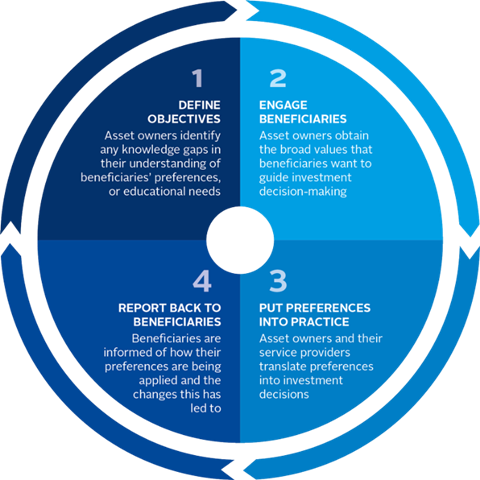By Emmet McNamee, Senior Specialist, Stewardship (Active Ownership 2.0), PRI

The capital of individual savers powers the investment industry but savers themselves tend to play a muted role. This is a feature, not a bug, of the industry’s design.
The world of investments is complex and difficult for laypeople to navigate. In the modern economy, people have more pressing and entertaining matters to occupy them over the minutiae of how their long-term savings are invested. Pension system features such as auto-enrolment and default investment strategies are premised on beneficiary disengagement and inertia.
Yet, in a heavily intermediated investment industry, a lack of beneficiary voice can exacerbate principal-agent problems and lead to decision-making that neglects beneficiaries’ broad interests. Existing evidence suggests beneficiaries tend to prefer investments that are more sustainable, that contribute to positive outcomes, and want more information on the sustainability performance of their investments.
Beneficiaries are increasingly keen to have a say in how their money is invested. Asset owners around the world have been targeted by beneficiaries due to their investment practices. Campaigns such as Make My Money Matter have also sought to engage and educate beneficiaries about the role their pensions play in the world. With the EU introducing requirements for entities to obtain the sustainability preferences of clients, and several stewardship codes encouraging a greater understanding of beneficiary preferences, empowering savers is also becoming an area of interest for regulators.
Our members told us clearly – they want ambition and urgency in how the Environment Agency Pension Fund invests and for us to be maximising the positive impact that we can have
Marion Maloney, Head of Responsible Investment and Governance, Environment Agency Pension Fund:
These trends have led PRI to develop guidance, setting out how asset owners can best understand the sustainability preferences of their beneficiaries and incorporate these preferences into investment decision-making. This sits alongside the other work PRI has undertaken on selecting, appointing and monitoring asset managers, as well as work on setting an RI policy.
Though there is no “one size fits all” format, we propose a simple four-step process for understanding and aligning with beneficiary preferences. Alongside this, we have also prepared a survey template which asset owners can adapt to obtain relevant information about beneficiaries’ preferences.

Engaging beneficiaries involves a careful balancing act for the asset owner. Beneficiaries have effectively outsourced investment decision-making to experts who bear the responsibility for the financial outcomes of those investment decisions, as reflected in fiduciary duties. Yet, as beneficiaries increasingly bear the risk of their investments and their awareness grows, the desire to reflect commonly-held values in decision making will grow.
This is not merely “the right thing to do”; there are several benefits asset owners can realise through engaging beneficiaries. Asset owners report their engagement efforts as a competitive advantage in markets where beneficiaries can choose between asset owners. It can lead to increased contribution levels as beneficiaries become more engaged with the saving process. It is also an opportunity to educate beneficiaries – whether on the basics of how pensions work, how an asset owner approaches responsible investment, or the impact their investments can have on their lives and issues they are passionate about.
It can also provide a window into future sustainability trends. Beneficiaries are not just individuals who invest their money. They are also consumers, employees and citizens, whose spending, employment and voting decisions influence which companies and industries fail and which succeed, and which policies get passed. Some asset owners have already reported gains after taking action to align with beneficiary preferences.
The engagement strongly reinforced that we are focussed on the ESG issues that are material to our beneficiaries and their investment returns. It also provided insights about how we can better engage members, increase their understanding of the Fund’s decision making and, consequently, deepen the trust they place in us to look after their retirement savings
Nicole Bradford, Global Head of Responsible Investment at Cbus
The process has also become more straightforward for asset owners. The rise in digital tools has shifted the goal posts – opening opportunities for asset owners to gather and assess information that would have been cumbersome, expensive and time-consuming only a short time ago.
Developments in technology, shifting consumer trends, increasing regulatory interest and a pressing need to improve private saving rates means that beneficiaries’ role as a silent partner may be at an end. The processes outlined in this report provide a guide on how asset owners might start to think about opening this engagement process. The responsible investment industry needs to begin asking beneficiaries about the role they want their savings to play – there seems to be a lot to gain.
This blog is written by PRI staff members and guest contributors. Our goal is to contribute to the broader debate around topical issues and to help showcase some of our research and other work that we undertake in support of our signatories.Please note that although you can expect to find some posts here that broadly accord with the PRI’s official views, the blog authors write in their individual capacity and there is no “house view”. Nor do the views and opinions expressed on this blog constitute financial or other professional advice.If you have any questions, please contact us at [email protected].












